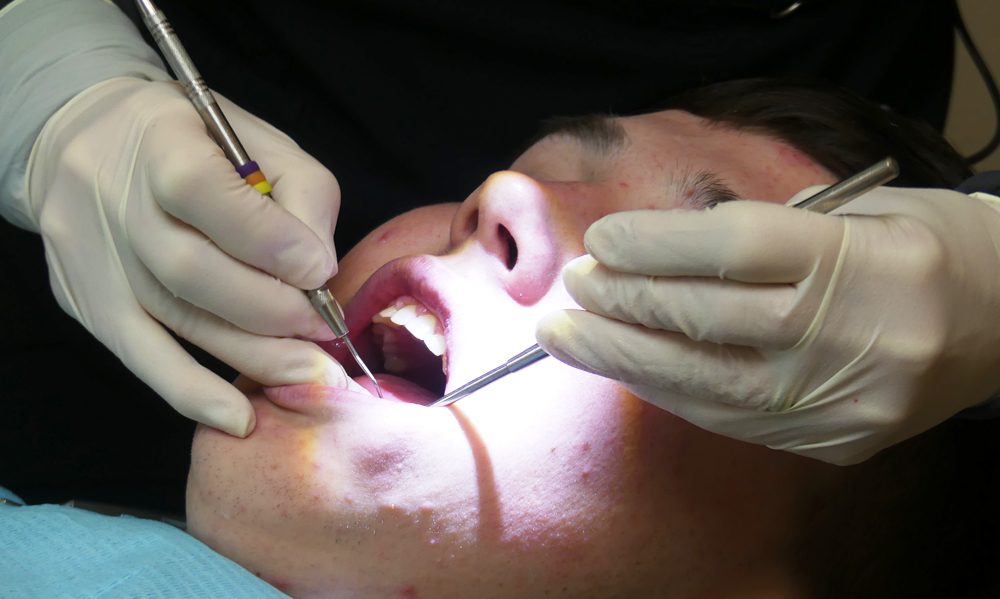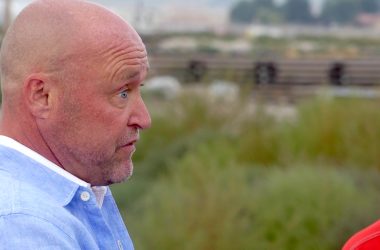 Brayden Gregory, 15, gets his teeth cleaned by Christi Phillips, a registered dental hygienist, and dentist Dr. Jacob Atkinson at Atkinson Dental in Vale. Gregory, who plays on the Vale High School football team, will be a sophomore this fall. (The Enterprise/Carolyn Agrimis)
Brayden Gregory, 15, gets his teeth cleaned by Christi Phillips, a registered dental hygienist, and dentist Dr. Jacob Atkinson at Atkinson Dental in Vale. Gregory, who plays on the Vale High School football team, will be a sophomore this fall. (The Enterprise/Carolyn Agrimis)
VALE – As kids across Malheur County count down their final days of summer and begin to fill their bags with school supplies, some of them might be showing up to school lacking one item: a healthy smile.
On any given day, 3,800 first through third graders across the state are suffering from dental pain or an infection, according to the 2012 Oregon Smile Survey produced by the Oregon Health Authority.
In eastern, more rural areas of Oregon, a staggering 73 percent of children that age experience tooth decay.
Dental issues like tooth decay, if left untreated, can lead to exacerbated problems that can impact lifelong physical and mental health of the child, experts say. Pain stemming from cavities or decay can impede a child’s ability to concentrate in school and may sometimes even stop them from attending if their pain is bad enough.
As the seriousness of dental issues has become more well known in recent years, resources across the state and in Malheur County have been made available to address dental issues.
“We were hearing anecdotally from school administrators that elementary school kids were absent due to dental pain,” said Melissa Freeman, the director of strategic projects at the Oregon Community Foundation.
“We invest a lot of dollars in early education,” said Freeman. “It struck our donors that this was a hidden epidemic happening in Oregon – kids in pain to the point they’re not showing up to school.”
In 2014, the Oregon Children’s Dental Health Initiative was formed by the foundation and allocated $2.5 million dollars over five years to improve dental health through education and preventative treatments such as sealants and fluoride applications.
Healthy, Happy Smiles! is one program in eastern Oregon that was funded by the initiative.
The school-based program is run by Eastern Oregon Healthy Living Alliance in partnership with Advantage Dental.
The Oregon dental company provides up to 30 percent of dental services across the state, according to the Advantage Dental website.
Healthy, Happy Smiles! provides free dental screenings, sealants, fluoride application, follow-up care for kids with urgent dental care needs, and free toothbrush kits.
School children can participate only with parental consent.
The program last school year served 4,670 children in 29 schools across Baker, Grant, Harney, and Malheur counties.
These counties were targeted because 73 percent of kids ages 6-9 residing in them have already experienced cavities compared to 52 percent of kids in the rest of the state, according to the program report for the 2017-18 school year.
“Malheur County is probably the lowest performing out of the four counties in eastern Oregon,” said John Adams, executive director of the health alliance.
Adams attributed this to Malheur County having the lowest rate of parental consent at 33 percent for the 2017-18 school year compared to 48 percent in Grant County, 69 percent in Baker County, and 86 percent in Harney County.
“We try to integrate (the consent forms) with fall registration,” said Adams. “At a couple of bigger schools, I think the paperwork was provided but it was kind of off to the side. So it was not fully integrated, and easy for them to skip over.”
“Getting kids, especially the older kids in middle school, to get their consent forms in is always challenging,” said Alanna Chamulak, program coordinator for the alliance.
“Even if you make it in their hands you can’t guarantee it’ll get signed, or if it gets signed you don’t know if it will get brought back,” she said.
To get more parental consent forms returned, Chamulak worked with other program coordinators and school administrators to come up with an incentive.
“Every student who returns a consent form either positive or negative is entered for a $10 gift card,” said Chamulak. “In Nyssa, they’re for Thunderegg Coffee, in Vale it’s Malheur Drug, so hopefully those will help get that form signed and turned back in.”
Chamulak helps run the Healthy, Happy Smiles! learning labs at local schools. Students learn about oral hygiene and prevention of dental diseases.
The labs are often set up in large classrooms or the school’s cafeteria and have five to six stations for students.
The younger students get work sheets and learn about proper brushing and flossing techniques and older students learn about tooth anatomy, the effects of tobacco and sugary foods on teeth as well as oral safety and dental careers.
“We touch on every area you could possibly think of when it comes to dental or oral health,” said Chamulak. “We always try to stress how it affects every other aspect of their life.”
By providing preventative care, school-based programs can reduce the likelihood of small dental issues snowballing into larger health problems later in the child’s life.
“We try to hit upon (oral hygiene) when the kids are in school through our health curriculum,” said Nicole Albisu, superintendent of the Ontario School District. “Having healthy bodies and a healthy lifestyle is something that we try to emphasize to our kids.” Albisu attributed a lack of education about oral hygiene as one reason why dental health is such an issue for students in Malheur County.
“A lot of families just don’t know what to do, or it’s not their priority,” she said. “Their priorities are shelter, food, things like that. Things like oral health are habits that have to be taught as well. If the parents don’t have good habits, they won’t teach their kids.”
Teaching kids about healthy dental habits is part of Jessica Steele’s job. Steele is Advantage Dental’s expanded practice dental hygienist for Malheur County and does the free screenings at local schools.
“I love helping kids,” said Steele.
“I know that I don’t function well with a toothache so a kid with a toothache is not at their top learning potential,” she said. “No one likes tooth pain. If we can prevent cavities, we can prevent a child from going through pain.”
If Steele comes across a child with urgent dental care needs, she’ll help the student get connected to a dentist.
For those students with a high amount of decay, Steele will come back after the initial screening day to track their progress. Healthy, Happy Smiles! visits schools with Advantage Dental happen in the fall.
At these visits, Advantage gives free dental kits that include floss, toothbrushes, and toothpaste, said Steele. Some schools will get follow up visits from Chamulak, depending on the number of kids who had urgent dental needs. Those check-ups usually happen in the spring, before the kids get out of school for the summer. They get another round of oral hygiene items like toothbrushes and toothpaste.
These personal hygiene items, seemingly trivial, aren’t always the easiest for needy kids to obtain, according to Freeman of the Oregon Community Foundation. “Toothbrushes and toothpaste not covered by SNAP,” said Freeman. SNAP stands for the supplemental nutrition assistance program.
In Malheur County, 3,629 out of 7,733 kids were benefitting from the SNAP program in 2017, according to a report from Children First for Oregon. The lack of access to basics such toothbrushes can turn a small dental problem into something more serious, said Freeman.
“People suck it up and deal with it for a long time and wait and then go to emergency room but then a dentist isn’t there,” she said. Oregon Community Foundation reported in 2014 that 2 percent, or around 29,000, of all visits to emergency departments in the state were for dental problems.
For Chamulak, the work that she does strikes a personal chord. “When I was a kid, my mom lost her job, and as a result our health insurance went away,” said Chamulak. “From the time I was 14 to 18, my siblings and I didn’t go to a dentist. It wasn’t an expense my parents wanted to spend because they thought ‘Oh, they brush their teeth, they don’t have to go to the dentist.’”
“Well, when I went when I was 18 it turned out I had some problems,” she said. “It sounds crazy but I was 19 years old when I was taught how to oss. So the fact that I can teach kids using my firsthand experience is really helpful. I love that I get to teach them early on, and hopefully it sticks.”
This school season will be the third year of Healthy, Happy Smiles in schools across Malheur County, funded by a $70,000 grant.




